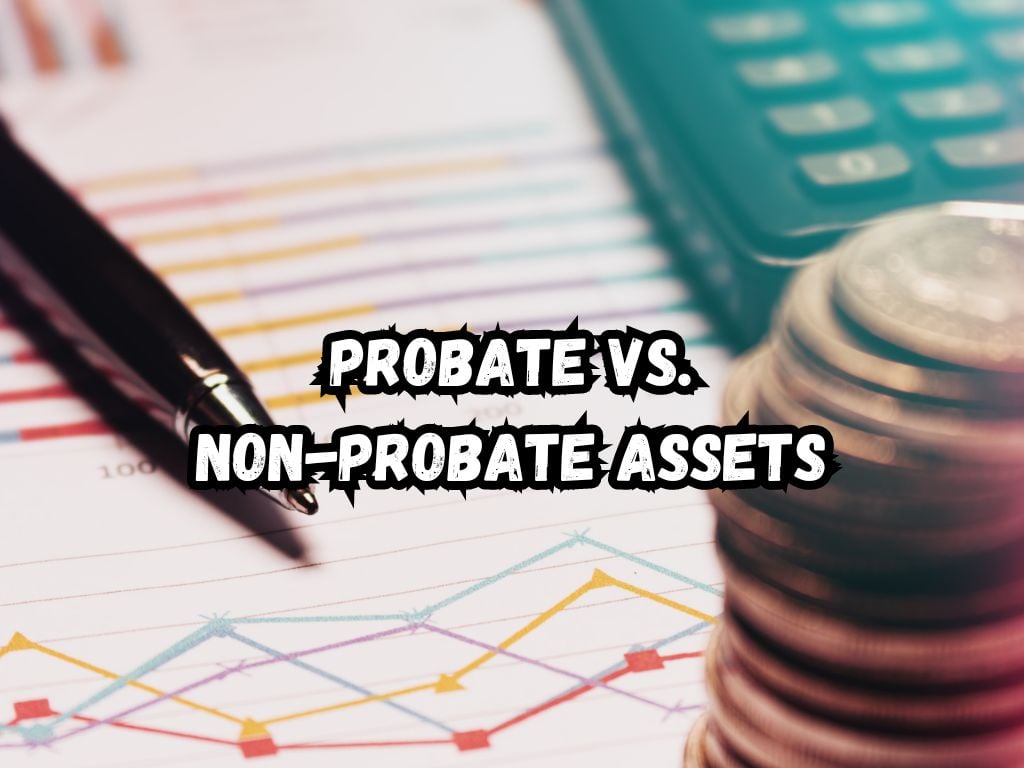When it comes to estate planning, understanding the subtleties between probate and non-probate assets is crucial. This isn’t just legal jargon but affects how your assets are handled, distributed, and potentially taxed after you pass away.
This guide demystifies probate vs non probate assets.
Probate vs Non Probate Assets
Understanding Probate Assets
Probate assets are those that require legal validation through a probate court after an individual’s death. This process is designed to ensure a deceased person’s assets are distributed according to their will or—if no will exists—state law.
Common examples of probate assets include individually-owned bank accounts, real estate in the sole name of the deceased, personal property like vehicles, and other items without a designated beneficiary.
The key characteristic of all probate assets is the need for court involvement to transfer ownership. If a person dies intestate, without a will, the probate court steps in to allocate assets according to state probate laws. This is often a public process and can become time-consuming and costly, involving legal fees, executor fees, court costs, and potential taxes.
Conversely, probate safeguards the decedent’s intent as expressed in the will and offers a supervised means of sorting out complex situations or disputes among heirs.

Exploring Non-Probate Assets
By contrast, non-probate assets bypass the court process and go directly to a named beneficiary or co-owner. These include items such as life insurance policies, retirement accounts like IRAs and 401(k)s, and jointly-owned property or accounts with rights of survivorship. Trust assets—property held in a living trust—also qualify as non-probate since the trust itself has its own directives for asset distribution.
Non-probate assets are attractive for their streamlined transfer process. They pass quickly to beneficiaries without the legal fees and delays inherent in probate.
This direct transfer also adds an element of privacy, avoiding the public recording that accompanies the probate of a will. Moreover, these assets can provide immediate financial support to beneficiaries, a critical factor in times of need.
On the other hand, the expedited process sometimes can result in oversights or misunderstandings if the ownership or beneficiary designations aren’t kept up-to-date.
Key Differences Between Probate and Non-Probate Assets
The major divide between these two categories lies in control and conveyance. With probate assets, the court has a fundamental role in the post-death asset transition, interpreting the will’s instructions or state laws where no will is present.
Non-probate assets, however, hinge more on predetermined arrangements like joint ownership or beneficiary designations that executor the decedent’s intentions without the court’s participations.
This procedural contrast impacts estate planning substantially. Those drafting a will must recognize that not all assets fall under its directives. Moreover, estate planning involves active management of how assets are titled and beneficiary designations to ensure they align with the person’s overall wishes.
Some assets can change categories through life events or modified designations, such as naming a trust as a beneficiary, so comprehending these differences is pivotal for accurate and effective estate planning.
Significance of Probate and Non-Probate Assets in Tax Planning
If you’re planning your estate, understanding tax implications of probate and non-probate assets is imperative. First, estate tax can apply irrespective of whether an asset is probate or non-probate, it depends on the net value at the time of death.
However, some non-probate assets can escape estate tax if they qualify for marital deduction or are payable directly to a tax-exempt charity. In addition, some states levy inheritance tax on probate property received by beneficiaries, but this typically doesn’t apply to spouses.
Furthermore, income tax could arise from distributions from retirement accounts which are considered non-probate. Consequently, strategic estate planning is critical to minimize tax liabilities and maximize inheritance.
Understanding tax nuances allows for the optimization of asset transfer by using the right mix of probate and non-probate assets.

Case Studies: Probate vs. Non-Probate Assets
Real-life case studies highlight the practical differences between probate and non-probate assets. Consider a scenario where an individual passes away owning a home in their name alone (probate asset) and a joint brokerage account with a child (non-probate asset).
The former requires court intervention for legal transfer, potentially leading to prolonged proceedings and fees, depending on the jurisdiction and complexity of the estate. In contrast, the brokerage account passes directly to the surviving child, bypassing probate entirely.
Another case involved a retirement account without a designated beneficiary (usually non-probate), which became probate because the lack of designation forced it into the estate, illustrating the importance of keeping such designations up to date. These cases exemplify how asset types can significantly alter the ease and cost of post-mortem asset distribution.
Conclusion
Whether you’re beginning to think about how to handle your estate or you are updating your existing plans, distinguishing between probate and non-probate assets is vital.
Not only does it affect how your assets are divided, but it also influences the speed, cost, and privacy of the process.
Given the intricacies and potential complications, consulting with an estate planning professional who can ensure your assets are properly designated and will reach your intended beneficiaries as smoothly as possible is always advisable.
Estate planning is not just for the wealthy; it’s a necessary step for anyone looking to manage their affairs responsibly. By understanding probate and non-probate assets, you take a significant step toward safeguarding your legacy and providing for your loved ones.
It’s an act of care that speaks volumes across generations, ensuring your wishes are respected and your beneficiaries are protected.
With this comprehensive overview, we hope you’ve gained clarity on probate vs. non-probate assets and how this knowledge can help you craft a secure plan for your estate.
Remember, regular reviews and adjustments to your estate plan are as essential as the initial design—life’s changes can shift the balance between these two classes of assets and thereby alter the execution of your estate plan.
Stay informed, stay prepared, and let your legacy reflect your life, your decisions, and your care for those you love.


 Tags:
Tags:










